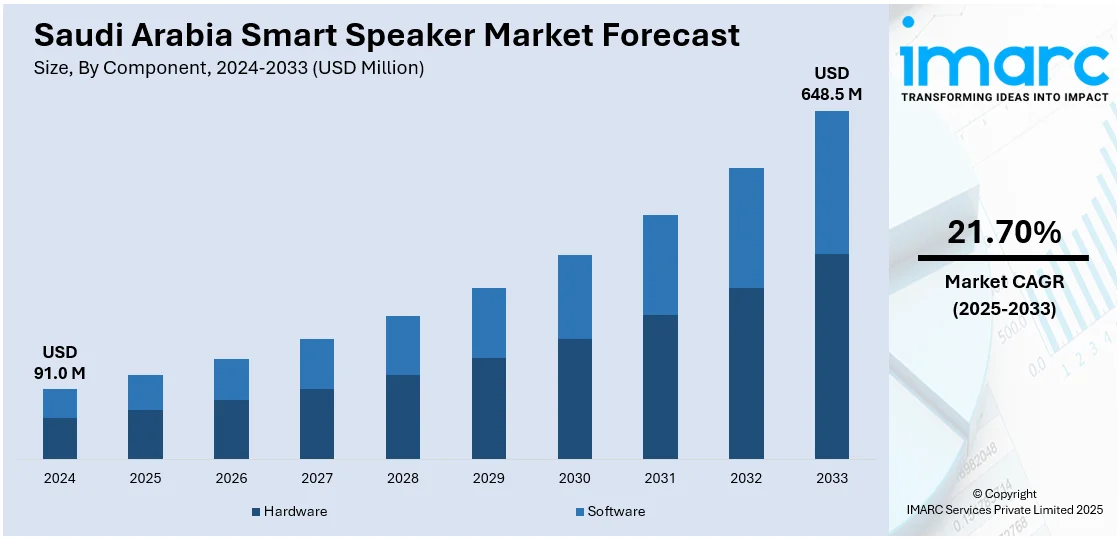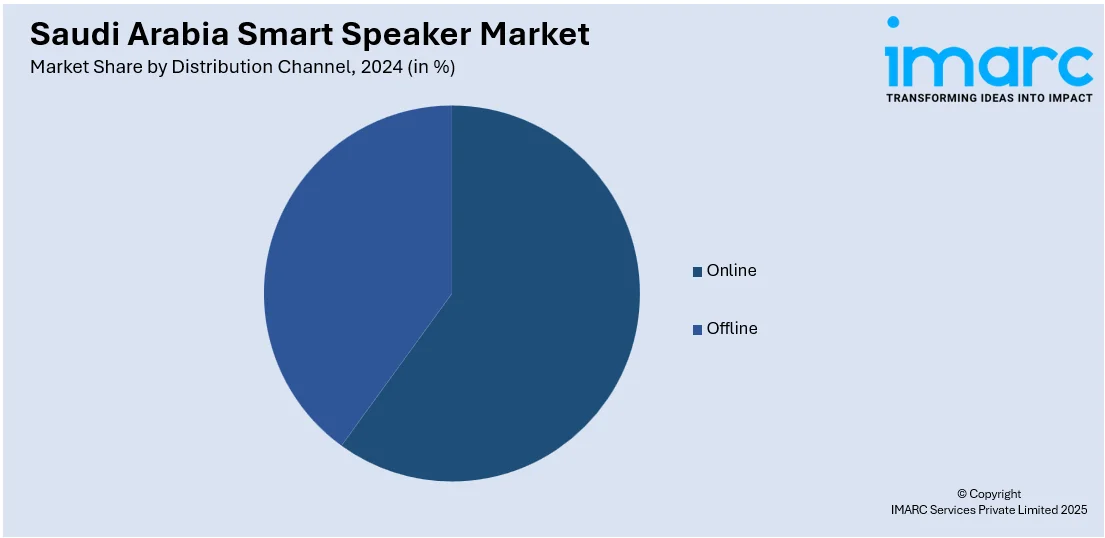
Saudi Arabia Smart Speaker Market Size, Share, Trends and Forecast by Component, Intelligent Virtual Assistant, Connectivity, Price Range, Distribution Channel, End User, and Region, 2025-2033
Saudi Arabia Smart Speaker Market Overview:
The Saudi Arabia smart speaker market size reached USD 91.0 Million in 2024. Looking forward, IMARC Group expects the market to reach USD 648.5 Million by 2033, exhibiting a growth rate (CAGR) of 21.70% during 2025-2033. The increasing use of smart home appliances, better voice recognition technologies, and the presence of support for the Arabic language are fueling the market. Governmental schemes such as Vision 2030, which focuses on economic diversification and technological incorporation, also support market growth.
|
Report Attribute
|
Key Statistics
|
|---|---|
|
Base Year
|
2024 |
|
Forecast Years
|
2025-2033
|
|
Historical Years
|
2019-2024
|
| Market Size in 2024 | USD 91.0 Million |
| Market Forecast in 2033 | USD 648.5 Million |
| Market Growth Rate 2025-2033 | 21.70% |
Saudi Arabia Smart Speaker Market Trends:
Increased Interoperability with Smart Home Devices
The Saudi Arabia smart speaker market share is increasing with the utilization of speakers as command-and-control hubs for comprehensive smart home platforms. This is being spurred by consumer interest in convenience, efficiency, and contemporary living experiences. With the growth of internet-connected devices like smart lights, thermostats, TVs, and security systems, smart speakers offer a natural, voice-controlled means to manage several functions simultaneously. Voice control allows users to dim lights, stream music, regulate indoor temperatures, or lock doors without moving a muscle. This kind of ease is particularly appealing to homeowners who appreciate cutting-edge living. The trend is also being driven by increasing compatibility of devices with leading voice assistant platforms, making it simpler for consumers to make various products compatible with one system. As life in Saudi Arabia grows digitized and technology-oriented, smart speakers are establishing themselves as integral parts of the connected home, further contributing to the Saudi Arabia smart speaker market growth. Recently, the Kingdom has launched national entities like the Saudi Data and AI Authority and the Future Factories Program to oversee and assist companies in embracing new technologies that leverage artificial intelligence, machine learning, 3D printing, and robotics. This intelligent infrastructure sector is anticipated to reach a value of USD 2 trillion over the next decade, rising from an estimated USD 900 billion in 2024, fueled by advances in the fusion of physical and digital industrial activities.

Growing Demand for Arabic Language and Localization Support
Cultural and linguistic relevance are emerging as key drivers of smart speaker success in Saudi Arabia. Consumers increasingly prefer devices that provide full Arabic support, including regional dialects, religious context, and cultural sensitivities. As voice assistants become advanced, their capacity to interpret local colloquialisms and deliver culturally sensitive answers is crucial to establishing trust and user adoption. This involves incorporating features like Islamic prayer times, local news feeds, and support for local streaming platforms. Businesses are also adapting the personality of voice assistants to appeal to local sensibilities, striking a balance between professionalism and cultural approachability. By making the experience intuitive and familiar, smart speaker providers are now able to reach out to a larger segment—ranging from techno-savvies to regular households. This localization phenomenon is also driving innovation among local developers, who are adding voice-based applications and content that provide a positive impact on the overall Saudi Arabia smart speaker market outlook.
Role of Government Vision and Digital Transformation
The market share is heavily driven by the government's strategic emphasis on digital transformation, especially under Vision 2030. The aim of this program is to transform the economy and decrease dependence on oil by building knowledge-based sectors, such as technology and innovation. Under this vision, smart technologies are being incorporated into new infrastructure, such as the creation of smart cities like NEOM. These futuristic urban zones are engineered to capitalize on artificial intelligence, IoT, and connectivity—making smart speakers a natural part of daily existence in such a setting. Cooperation between the public and private sectors is also driving innovation, with incentives for technology startups and international investors to take their smart home options to the Saudi market. Educational campaigns and online literacy programs are making people more at ease with new technologies. The encouragement and facilitation through government policies are driving both adoption and awareness, making smart speakers a regular presence in Saudi homes and workplaces.
Saudi Arabia Smart Speaker Market Segmentation:
IMARC Group provides an analysis of the key trends in each segment of the market, along with forecasts at the regional level for 2025-2033. Our report has categorized the market based on component, intelligent virtual assistant, connectivity, price range, distribution channel, and end user.
Component Insights:
- Hardware
- Software
The report has provided a detailed breakup and analysis of the market based on the component. This includes hardware and software.
Intelligent Virtual Assistant Insights:
- Amazon Alexa
- Google Assistant
- Siri
- Cortana
- Others
The report has provided a detailed breakup and analysis of the market based on the intelligent virtual assistant. This includes Amazon Alexa, Google assistant, Siri, Cortana, and others.
Connectivity Insights:
- Wi-Fi
- Bluetooth
A detailed breakup and analysis of the market based on the connectivity have also been provided in the report. This includes wi-fi and Bluetooth.
Price Range Insights:
- Low-range (Less than $100)
- Mid-range ($101 to $200)
- Premium (Above $200)
The report has provided a detailed breakup and analysis of the market based on the price range. This includes low-range (less than $100), mid-range ($101 to $200), and premium (above $200).
Distribution Channel Insights:

- Online
- Offline
The report has provided a detailed breakup and analysis of the market based on the distribution channel. This includes online and offline.
End User Insights:
- Personal
- Commercial
A detailed breakup and analysis of the market based on the end user have also been provided in the report. This includes personal and commercial.
Regional Insights:
- Northern and Central Region
- Western Region
- Eastern Region
- Southern Region
The report has also provided a comprehensive analysis of all the major regional markets, which include Northern and Central Region, Western Region, Eastern Region, and Southern Region.
Competitive Landscape:
The market research report has also provided a comprehensive analysis of the competitive landscape. Competitive analysis such as market structure, key player positioning, top winning strategies, competitive dashboard, and company evaluation quadrant has been covered in the report. Also, detailed profiles of all major companies have been provided.
Saudi Arabia Smart Speaker Market Report Coverage:
| Report Features | Details |
|---|---|
| Base Year of the Analysis | 2024 |
| Historical Period | 2019-2024 |
| Forecast Period | 2025-2033 |
| Units | Million USD |
| Scope of the Report |
Exploration of Historical Trends and Market Outlook, Industry Catalysts and Challenges, Segment-Wise Historical and Future Market Assessment:
|
| Components Covered | Hardware, Software |
| Intelligent Virtual Assistants Covered | Amazon Alexa, Google Assistant, Siri, Cortana, Others |
| Connectivities Covered | Wi-Fi, Bluetooth |
| Price Ranges Covered | Low-range (Less than $100), Mid-range ($101 to $200), Premium (Above $200) |
| Distribution Channels Covered | Online, Offline |
| End Users Covered | Personal, Commercial |
| Regions Covered | Northern and Central Region, Western Region, Eastern Region, Southern Region |
| Customization Scope | 10% Free Customization |
| Post-Sale Analyst Support | 10-12 Weeks |
| Delivery Format | PDF and Excel through Email (We can also provide the editable version of the report in PPT/Word format on special request) |
Key Questions Answered in This Report:
- How has the Saudi Arabia smart speaker market performed so far and how will it perform in the coming years?
- What is the breakup of the Saudi Arabia smart speaker market on the basis of component?
- What is the breakup of the Saudi Arabia smart speaker market on the basis of intelligent virtual assistant?
- What is the breakup of the Saudi Arabia smart speaker market on the basis of connectivity?
- What is the breakup of the Saudi Arabia smart speaker market on the basis of price range?
- What is the breakup of the Saudi Arabia smart speaker market on the basis of distribution channel?
- What is the breakup of the Saudi Arabia smart speaker market on the basis of end user?
- What is the breakup of the Saudi Arabia smart speaker market on the basis of region?
- What are the various stages in the value chain of the Saudi Arabia smart speaker market?
- What are the key driving factors and challenges in the Saudi Arabia smart speaker market?
- What is the structure of the Saudi Arabia smart speaker market and who are the key players?
- What is the degree of competition in the Saudi Arabia smart speaker market?
Key Benefits for Stakeholders:
- IMARC’s industry report offers a comprehensive quantitative analysis of various market segments, historical and current market trends, market forecasts, and dynamics of the Saudi Arabia smart speaker market from 2019-2033.
- The research report provides the latest information on the market drivers, challenges, and opportunities in the Saudi Arabia smart speaker market.
- Porter's five forces analysis assist stakeholders in assessing the impact of new entrants, competitive rivalry, supplier power, buyer power, and the threat of substitution. It helps stakeholders to analyze the level of competition within the Saudi Arabia smart speaker industry and its attractiveness.
- Competitive landscape allows stakeholders to understand their competitive environment and provides an insight into the current positions of key players in the market.
Need more help?
- Speak to our experienced analysts for insights on the current market scenarios.
- Include additional segments and countries to customize the report as per your requirement.
- Gain an unparalleled competitive advantage in your domain by understanding how to utilize the report and positively impacting your operations and revenue.
- For further assistance, please connect with our analysts.
 Request Customization
Request Customization
 Speak to an Analyst
Speak to an Analyst
 Request Brochure
Request Brochure
 Inquire Before Buying
Inquire Before Buying




.webp)




.webp)












